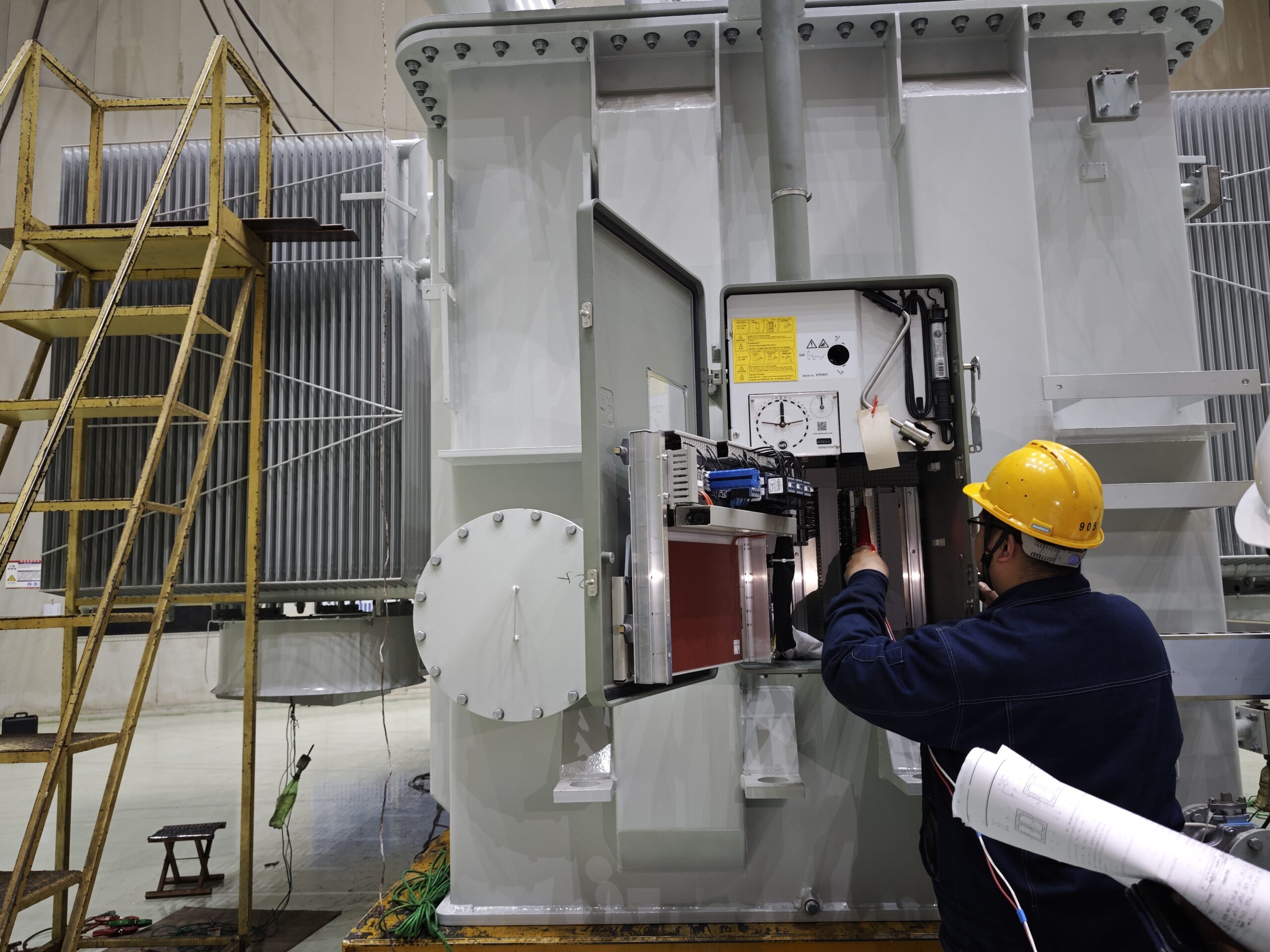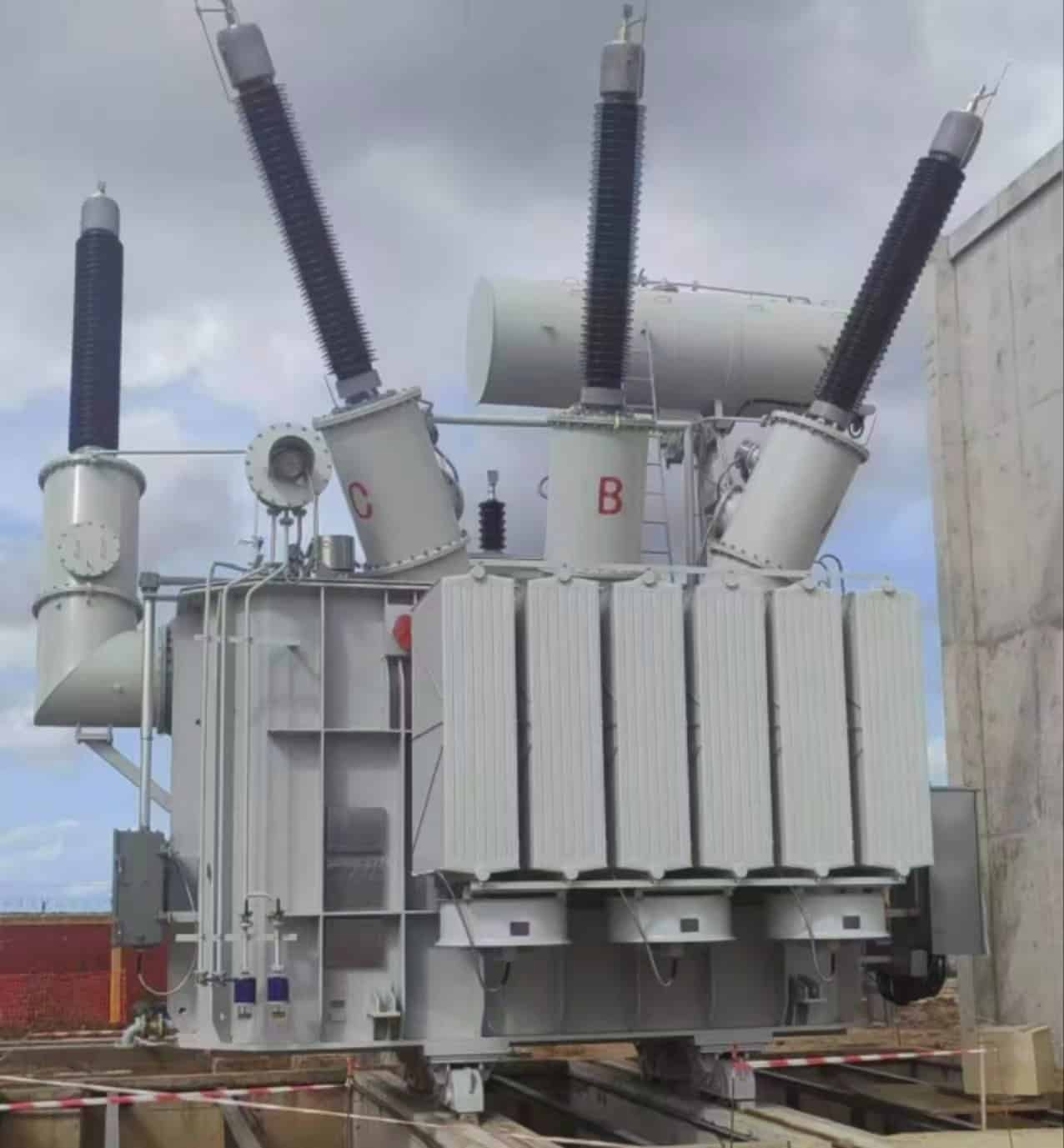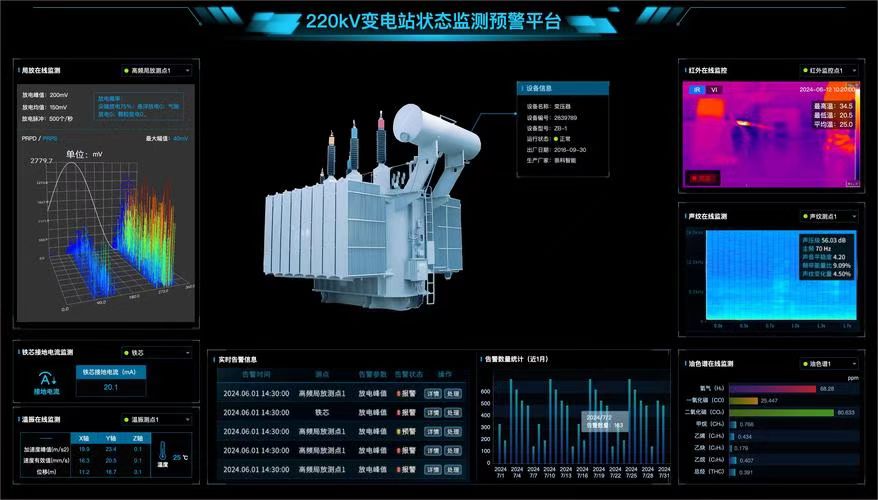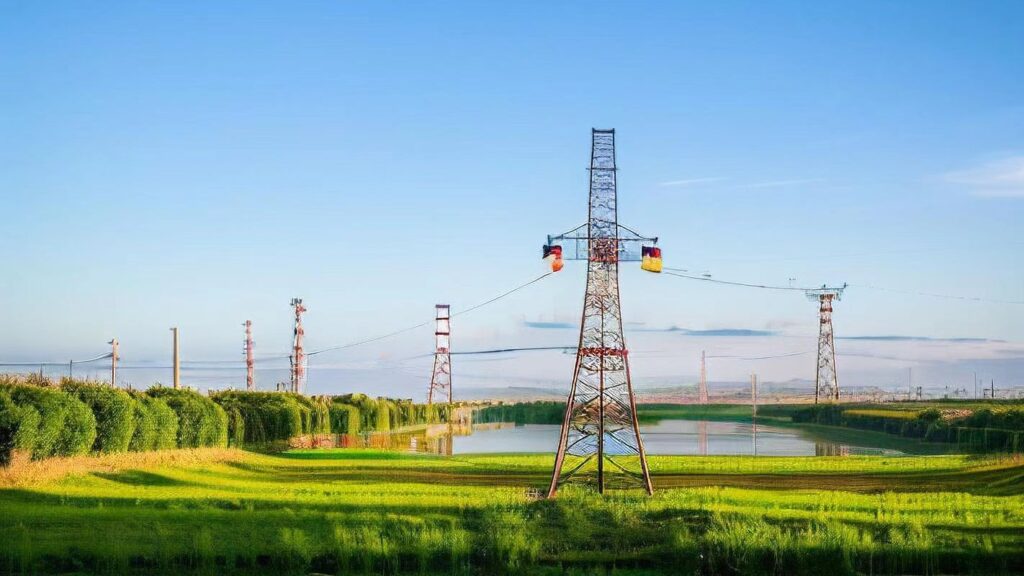Transformers are built for continuous operation, but sometimes they trip—shutting down automatically due to abnormal conditions. A transformer trip is a protective response to prevent equipment damage, fire, or safety hazards. Understanding the reasons behind transformer tripping helps operators diagnose problems early and maintain reliable power delivery.
What Does It Mean When a Transformer Trips?

When we say a transformer has “tripped,” it doesn’t mean it has physically fallen or broken apart. Rather, it’s a technical term in the electrical power industry indicating that the transformer has been automatically disconnected from the circuit by a protection system due to an abnormal or dangerous condition. Tripping is a critical self-protection mechanism designed to prevent severe damage, fire, or system instability.
A transformer trip occurs when a protective relay detects a fault or unsafe operating condition—such as overcurrent, differential current, internal fault, over-temperature, or Buchholz gas accumulation—and sends a signal to open a circuit breaker. This disconnects the transformer from the power system to prevent further damage or danger.
A trip is not a failure; it's a protective response to a detected abnormality.
A transformer trip is a protective shutdown triggered by a relay in response to a fault or unsafe condition.True
Trips are intentional disconnections to isolate transformers from damage or risk.
When a transformer trips, it means the transformer is destroyed.False
Tripping is a preventive measure; the transformer is not necessarily damaged but is temporarily taken offline to avoid failure.
1. What Triggers a Transformer Trip?
| Trigger Condition | Cause or Scenario |
|---|---|
| Overcurrent | Short circuits, load surges, or ground faults |
| Differential protection (87T) | Internal winding fault or insulation failure |
| Over-temperature (49 or RTD trip) | Cooling failure or prolonged overload |
| Buchholz relay trip | Gas generation due to arcing or oil movement |
| Restricted Earth Fault (REF) | Low-impedance ground fault inside transformer |
| External grid fault | Backfeeding or voltage instability triggering protection |
Trips are based on protection logic, not random events.
2. What Happens During a Trip?
| Event | What Occurs |
|---|---|
| Protective relay triggers | Detects fault and sends signal to breaker |
| Circuit breaker opens | Disconnects transformer from load or source |
| Alarms activate | SCADA or control panel logs the trip event |
| Transformer is de-energized | Stops power flow, halts further fault escalation |
| Investigation begins | Field team inspects logs, relays, and physical conditions |
The system is isolated for safety and can only be re-energized after inspection or reset.
3. Types of Protection That Can Cause Tripping
| Protection Type | Code/Standard Reference | Function |
|---|---|---|
| Differential Protection | ANSI 87T | Detects internal winding faults |
| Overcurrent Protection | ANSI 50/51 | Responds to load surges or short circuits |
| Buchholz Relay | IEC 60296 / ANSI device 63 | Gas or oil surge detection in conservator units |
| Temperature Protection | ANSI 49 or RTD-based systems | Trips on overheating of oil or windings |
| Earth Fault Protection | ANSI 50N/51N or 64REF | Detects leakage to ground |
These systems protect both the transformer and surrounding grid from cascading damage.
4. Is Tripping Always a Sign of Transformer Damage?
| Trip Cause | Transformer Condition | Post-Trip Action |
|---|---|---|
| External fault (line trip) | Transformer likely unaffected | Reclose breaker after grid stabilization |
| Overload condition | Transformer protection worked as intended | Load balancing or derating may be needed |
| Buchholz relay gas | Possible internal arc → gas analysis required | Perform DGA, pressure check, oil test |
| Differential trip | High chance of winding or insulation damage | Must be tested and inspected before restart |
Not all trips mean damage—but they all mean attention is required.
5. Real-World Example: Transformer Trip Scenario
- Transformer: 66/11 kV, 20 MVA
- Trip trigger: Differential protection relay 87T
- Field finding: B-phase winding insulation degraded, turn-to-turn arc
- Result: Unit isolated before explosion, limited oil damage
- Action: Transported for rewind; system restored via spare
- Lesson: Trip saved transformer from total destruction
Tripping prevents escalation from fault to fire or system-wide blackout.
6. How Utilities Handle Transformer Trips
| Response Step | Purpose |
|---|---|
| Acknowledge alarm (SCADA) | Confirm fault signal and isolate other risks |
| Dispatch field inspection team | Physically inspect oil, bushings, terminals, grounding |
| Download relay event logs | Analyze timing, magnitude, and fault origin |
| Run diagnostics (DGA, IR, etc.) | Identify cause if internal fault suspected |
| Decide on reset, repair, or replace | Based on test results and criticality |
A transformer trip is an urgent, not emergency, condition—action must be swift but smart.
Summary Table: What It Means When a Transformer Trips
| Trip Type | Meaning | Next Action |
|---|---|---|
| Overcurrent trip | Load exceeded safe levels | Investigate load, relay coordination |
| Differential trip (87T) | Internal winding or insulation fault | Offline testing, potential replacement |
| Buchholz relay trip | Internal gas generation from arcing | DGA, oil sampling, internal inspection |
| Over-temperature trip | Cooling system failure or overload | Check radiators, fans, temperature logs |
| Earth fault trip | Leakage path to ground detected | Inspect bushings, grounding, connections |
How Do Overcurrents or Short Circuits Cause Transformer Tripping?
Transformer protection systems are designed to sense abnormal electrical conditions and act fast to prevent severe damage. Overcurrents and short circuits are two of the most dangerous and immediate threats to transformer health. These conditions dramatically increase the current flowing through the windings, and without rapid detection and disconnection, they can destroy insulation, deform windings, and even cause fire or explosions. Tripping in response to such events is a deliberate and critical action by the protection system.
Overcurrents and short circuits cause a transformer to trip when protective relays detect current levels exceeding safe operating thresholds. These relays immediately signal circuit breakers to open, disconnecting the transformer from the fault path. This prevents thermal damage, mechanical stress, and catastrophic failure inside the transformer windings or core.
Tripping is the first line of defense against electrical fault escalation.
Transformer protection systems trip the unit during overcurrent or short-circuit conditions to prevent insulation damage and overheating.True
Excess current can quickly exceed thermal and dielectric limits, making fast disconnection essential to protect the transformer.
Transformers can handle overcurrents indefinitely without tripping if oil cooling is adequate.False
Transformers are designed for specific current ratings; sustained overcurrent or short circuits cause rapid internal heating and dielectric failure.
1. What Is an Overcurrent or Short Circuit?
| Type | Definition | Example |
|---|---|---|
| Overcurrent | Current exceeds nameplate rating for a sustained period | 130% of rated current during peak load |
| Short Circuit | Fault causes near-zero impedance path → massive current spike | Phase-to-phase or phase-to-ground fault |
| Symmetrical fault | Balanced short across all phases | Substation busbar fault |
| Asymmetrical fault | Unbalanced fault (e.g. single-line-to-ground) | Distribution line damage |
Even momentary short circuits can generate thousands of amps, far beyond transformer design limits.
2. How Overcurrents Damage Transformers
| Overcurrent Effect | Impact on Transformer |
|---|---|
| Rapid winding heating | Degrades insulation and causes thermal stress |
| Increased eddy current losses | Elevates core temperature, leads to mechanical distortion |
| Tank pressure rise | Oil boils → gas formation → pressure build-up |
| Cumulative insulation aging | Reduces lifespan of cellulose paper and oil systems |
A 5× rated current during a short circuit can raise winding temperatures >250°C in seconds.
3. Role of Protection Relays During Overcurrents
| Relay Type | Function |
|---|---|
| Instantaneous Overcurrent (50) | Trips immediately on high fault current |
| Inverse Time Overcurrent (51) | Delays trip based on fault severity and duration |
| Differential Protection (87T) | Detects internal short circuits between phases |
| Restricted Earth Fault (REF) | Detects ground leakage inside transformer |
These relays are coordinated to trip before the transformer is damaged, but after upstream clearance delays.
4. Sequence of Events When a Short Circuit Occurs
| Step | What Happens |
|---|---|
| 1. Fault causes high current | Windings experience sudden spike in amperage |
| 2. Relay detects threshold breach | Current exceeds preset value in overcurrent relay |
| 3. Relay sends trip command | Signal sent to circuit breaker |
| 4. Breaker opens the circuit | Transformer disconnected from fault path |
| 5. Alarm and SCADA log entry | Trip recorded, initiating fault investigation |
Typical tripping time: <100 milliseconds for short circuits, 0.3–2 seconds for overcurrent conditions.
5. Real-World Example: Overcurrent-Induced Transformer Trip
- Transformer: 11/0.4 kV, 250 kVA distribution
- Event: Tree fell on LV line, causing phase-to-ground short
- Response: Overcurrent relay (50) detected 12× rated current
- Breaker trip time: 90 milliseconds
- Result: Transformer undamaged due to fast isolation
- Lesson: Proper relay settings and fast-acting breakers prevented thermal overload
6. What Happens If Overcurrent Goes Undetected?
| Failure Mode | Root Cause | Consequence |
|---|---|---|
| Winding deformation | High current force | Short circuits between turns |
| Oil carbonization | Overheating due to poor cooling | Reduced dielectric strength → flashover |
| Terminal burnout | Sustained overheating at lugs | Open circuit, arcing |
| Complete transformer burnout | Prolonged exposure to fault conditions | Explosion, oil fire, total loss |
Transformers are not designed for fault current endurance—only fast protection can save them.
7. Best Practices for Preventing Overcurrent and Short Circuit Damage
| Action | Why It Matters |
|---|---|
| Correct relay settings | Ensures fast trip under fault, avoids nuisance trips |
| Routine relay testing | Verifies actual vs. expected response times |
| SCADA event log monitoring | Early detection of abnormal current trends |
| Load profiling and balancing | Prevents chronic overcurrent in one phase |
| Proper coordination with fuses and upstream breakers | Avoids over/under-protection |
Transformer protection is only effective when calibrated and maintained properly.
Summary Table: Overcurrents and Short Circuits Causing Transformer Tripping
| Fault Type | Current Impact | Relay Type | Trip Response |
|---|---|---|---|
| Overload (>120%) | Sustained overcurrent | 51 (Inverse Time Overcurrent) | Delayed trip (1–5 sec) |
| Phase-phase short | Instantaneous surge | 50 (Instantaneous OC) | Instant trip (<100 ms) |
| Internal winding fault | Differential current | 87T (Differential Protection) | Fast trip (typically <1 sec) |
| Ground fault | Asymmetrical leakage | REF or 50N | Trip with ground fault detection |
What Role Does Differential Protection Play in Tripping?
Transformers, as core elements of the power grid, require precise and responsive protection systems. Among the most critical is differential protection, a fast and sensitive relay-based method used to detect internal faults. Unlike overcurrent or ground fault protection—which may respond to external disturbances—differential protection targets faults inside the transformer itself by comparing current flow into and out of the transformer in real time.
Differential protection plays a central role in tripping transformers by detecting internal faults—such as winding short circuits or insulation failure—based on differences between input and output currents. When the discrepancy exceeds a set threshold, the differential relay (ANSI 87T) sends a trip command to the circuit breaker, instantly isolating the transformer to prevent major damage or fire.
This protection mechanism ensures rapid isolation of the most dangerous, destructive faults.
Differential protection detects internal faults in transformers by comparing incoming and outgoing current levels.True
If the current difference exceeds the allowable margin, the relay trips to prevent winding damage, arcing, and thermal failure.
Differential protection responds to external grid faults and does not protect against internal transformer damage.False
Differential protection is specifically designed for internal faults, not external disturbances.
1. How Differential Protection Works
| Concept | Mechanism |
|---|---|
| Current balance principle | Current entering = current leaving under normal operation |
| CTs (Current Transformers) | Measure current on both HV and LV sides |
| Differential relay logic (87T) | Calculates the difference between input and output current |
| Trip signal condition | If differential current > set threshold → trip is triggered |
Under normal conditions, I₁ – I₂ ≈ 0 (after accounting for CT ratio and transformer vector group).
2. Typical Faults Detected by Differential Protection
| Internal Fault Type | Description |
|---|---|
| Turn-to-turn winding fault | Short circuit between adjacent winding turns |
| Phase-to-phase fault | Internal arc between phases within the transformer |
| Phase-to-ground fault | Leakage or flashover to grounded tank |
| Bushing internal arc | Arcing inside bushing porcelain insulation |
| Winding movement or core shift | Causes asymmetrical currents due to mechanical displacement |
These faults develop inside the transformer, and external protections may not detect them early.
3. Trip Logic of Differential Relays
| Parameter | Role in Protection |
|---|---|
| Pickup current (bias setting) | Prevents nuisance tripping due to CT errors or inrush |
| Slope settings | Allows proportional tolerance at higher load levels |
| Harmonic restraint | Blocks tripping during magnetizing inrush conditions |
| Stabilization | Filters out CT saturation effects |
Modern digital relays use adaptive algorithms to distinguish faults from harmless transients.
4. Inrush Current vs. Internal Faults
| Condition | Differential Behavior | Trip Decision |
|---|---|---|
| Transformer energization | High current with 2nd harmonic component | No trip (harmonic restraint) |
| Internal fault | High differential current with no harmonics | Trip |
This distinction prevents false tripping during safe startup conditions.
5. Real-World Example: Differential Trip Saves Transformer
- Transformer: 132/33 kV, 100 MVA
- Scenario: Unexpected differential trip during night operation
- Analysis: B-phase winding showed internal arc; oil sample had high C₂H₂
- Relay: ANSI 87T tripped in 50 ms, prevented tank explosion
- Outcome: Transformer isolated, rewound, and restored after 2 weeks
- Lesson: Without differential protection, failure would’ve escalated to fire
6. Benefits of Differential Protection in Transformers
| Benefit | Why It Matters |
|---|---|
| Speed (20–100 ms trip) | Stops fault before thermal/mechanical damage escalates |
| Sensitivity | Detects faults undetectable by external relays |
| Security (low false trip rate) | Advanced logic minimizes unnecessary disconnections |
| Custom configuration | Adjustable to transformer rating, CT ratio, vector group |
Differential protection is mandatory for large and critical power transformers per IEEE and IEC.
7. How to Maintain and Test Differential Protection
| Maintenance Task | Frequency | Purpose |
|---|---|---|
| Secondary injection testing | Annually or bi-annually | Validates relay function under simulated fault |
| CT ratio and polarity verification | During commissioning or repair | Ensures accurate current comparison |
| Harmonic restraint calibration | During relay configuration | Prevents tripping on inrush |
| Relay event log review | After any trip or disturbance | Confirms if trip was justified |
A misconfigured or untested relay may fail to trip—or trip unnecessarily.
Summary Table: Role of Differential Protection in Transformer Tripping
| Function | Response to Fault | Trip Action |
|---|---|---|
| Compare HV and LV currents | Internal fault causes imbalance | Relay trips circuit breaker |
| Filter out inrush harmonics | Avoid false trips during energization | Relay blocks trip if harmonic detected |
| Detect winding insulation failure | High-speed detection of short circuits | Instant isolation of transformer |
| Enhance transformer reliability | Prevents secondary damage and fire | Preserves transformer and system uptime |
How Can Overheating or High Oil Temperature Trigger a Trip?
Transformers convert and transmit power under heavy loads, but they do so within strict thermal limits. If these limits are exceeded—whether due to excessive load, cooling failure, or environmental conditions—the risk of insulation breakdown and catastrophic failure rises sharply. To prevent this, transformers are equipped with thermal protection systems that monitor oil and winding temperatures. When critical thresholds are reached, they trigger an automatic trip to disconnect the transformer.
Overheating or high oil temperature can trigger a transformer trip when thermal sensors (RTDs) or thermal relays detect that the temperature exceeds safe operational limits. These sensors signal the protection relay (ANSI 49) or temperature monitoring unit to trip the associated circuit breaker, disconnecting the transformer from service to prevent insulation damage, core saturation, or fire.
Thermal protection is essential for preventing failure due to cumulative heat stress or sudden cooling malfunction.
High oil or winding temperature can trip a transformer through thermal protection relays to prevent overheating damage.True
Thermal relays disconnect the transformer when temperature thresholds are exceeded, avoiding insulation breakdown and fire.
Transformers can safely operate beyond rated temperature as long as the load is balanced.False
Excessive temperature, regardless of balance, accelerates insulation aging and can cause failure if not controlled.
1. What Causes Overheating in Transformers?
| Cause | How It Leads to High Temperature |
|---|---|
| Overload condition | Increases I²R losses in windings → internal heat rise |
| Cooling system failure | Fans, pumps, or radiators stop working → heat accumulates |
| Ambient temperature spike | Reduces cooling effectiveness → raises transformer temp |
| Insulation degradation | Increases dielectric losses → added internal heat |
| Oil sludging or contamination | Blocks heat flow and reduces oil convection |
Heat is the primary aging agent for transformer insulation—every 10°C rise cuts insulation life in half.
2. Thermal Protection Devices That Detect Overheating
| Device | Function |
|---|---|
| RTDs (Resistance Temperature Detectors) | Measure winding or core temperature directly |
| Oil temperature sensors | Detect top-oil temperature in the tank |
| Thermal relays (ANSI 49) | Provide trip logic based on preset temperature curves |
| Temperature monitoring relay (e.g., WTI/OTI) | Warn or trip based on oil/winding temperature |
| Digital SCADA-based monitoring | Logs temperature trends and triggers remote alarms |
These devices work together to continuously monitor thermal status and issue trip commands if thresholds are crossed.
3. Trip Thresholds for Overtemperature Protection
| Component | Typical Alarm Point | Trip Threshold |
|---|---|---|
| Top-oil temperature | 80–90°C | 95–105°C |
| Winding hot-spot | 110–120°C | 130–140°C |
| Ambient temperature compensation | Adjusted dynamically | Maintains allowable rise |
Exact values vary by design, cooling class (ONAN, ONAF), and transformer rating. Setpoints follow IEEE C57 and IEC 60076 standards.
4. Sequence: How Overheating Leads to Tripping
| Step | Event in Transformer |
|---|---|
| 1. Load or cooling issue occurs | Heat builds up in oil and windings |
| 2. RTDs detect temperature rise | Temperature exceeds programmed limits |
| 3. Thermal relay calculates thermal model | Compares real-time temp vs. safe operating curve |
| 4. Relay sends trip command | Triggers circuit breaker to isolate transformer |
| 5. SCADA logs event and alarms | Initiates investigation and cooling check |
Tripping is faster if temperature rises sharply, and delayed if within time-delay thresholds.
5. Real-World Example: Overtemperature Trip Event
- Transformer: 33/11 kV, 16 MVA
- Cooling: ONAN/ONAF with two-stage fan system
- Event: Fans failed during high summer load, ambient 42°C
- OTI reading: Peaked at 106°C
- Action: Thermal relay tripped transformer after 6 minutes
- Result: Transformer safely shut down, oil remained below flash point
- Postmortem: Fan controller failure + missed maintenance interval
Trip prevented a permanent insulation collapse and potential fire.
6. Why Tripping on Overheating Is Critical
| Reason | Explanation |
|---|---|
| Insulation aging | Higher temperatures exponentially reduce paper strength |
| Oil degradation | Overheated oil forms acids, sludge, and carbon particles |
| Risk of internal arcing | Hot spots lower dielectric strength → flashover risk |
| Fire hazard | Oil temperature near flashpoint leads to ignition |
Overheating-related failures are often irreversible, making thermal tripping a vital protection layer.
7. How to Prevent Thermal Trips in Transformers
| Preventive Measure | Benefit |
|---|---|
| Routine cooling system checks | Keeps fans, pumps, radiators in optimal condition |
| Load profiling and balancing | Prevents chronic overloads |
| Oil filtration and sludge removal | Restores thermal conductivity |
| Online thermal monitoring | Enables predictive maintenance |
| Setpoint review and relay testing | Ensures accurate response during thermal events |
Proactive thermal management extends transformer life and avoids false or emergency trips.
Summary Table: How Overheating or High Oil Temperature Triggers a Transformer Trip
| Cause of Overheating | Detection Method | Protection Device | Trip Outcome |
|---|---|---|---|
| Load-induced heating | RTDs, OTI | Thermal relay (ANSI 49) | Breaker opens to isolate transformer |
| Cooling system failure | Oil temp sensor, WTI | Trip at 95–105°C | System alarm, unit disconnected |
| Ambient spike + overload | SCADA input + RTDs | Auto-compensated threshold | Trip + dispatch for inspection |
| Blocked radiator airflow | Slow oil temp rise | Trip after thermal delay | Time-lag trip to allow cooldown |
Can External Grid Faults Lead to Transformer Tripping?

While transformer protection systems are primarily designed to respond to internal faults, external grid faults—such as short circuits, switching surges, or severe voltage dips—can also lead to transformer tripping. These disturbances often propagate through the grid and stress the transformer electrically or thermally, triggering protective devices to isolate it from broader system instability or damage.
Yes, external grid faults can cause a transformer to trip if the fault current or voltage disturbance reaches the transformer terminals and activates protection devices such as overcurrent, differential, restricted earth fault (REF), or relay zone protections. The transformer itself may not be damaged, but protective coordination ensures it is safely disconnected to prevent cascading failure or stress-related degradation.
Understanding these interactions is key to designing resilient grids and transformer protections.
External faults on the power grid can lead to transformer tripping through relay activation when fault currents flow through the transformer.True
Transformers can experience elevated through-fault currents or voltage fluctuations during grid faults, triggering protection schemes.
Transformers only trip due to faults within themselves, not from external grid disturbances.False
While transformer protection focuses on internal conditions, coordinated relay systems can trip transformers in response to external faults to prevent damage.
1. What Is an External Grid Fault?
| Fault Type | Description |
|---|---|
| Line-to-line short circuit | Phases touch or arc on transmission/distribution line |
| Ground fault (SLG or DLG) | One or more phases short to ground |
| Breaker failure or misoperation | Improper isolation of a fault feeds transient currents |
| Capacitor or load switching surge | Sudden voltage transient reflected into transformer |
| Voltage sag or instability | Large load drop, generation failure, or frequency deviation |
These events originate outside the transformer, but their impact is often felt at the transformer terminals.
2. How External Faults Propagate to the Transformer
| Impact Mechanism | Transformer Exposure |
|---|---|
| Through-fault current | Fault current flows through transformer windings |
| Voltage dips/swells | Dielectric and control systems stressed |
| High inrush surges | Trigger harmonic generation or relay misoperation |
| Magnetic asymmetry | Unbalanced grid voltages cause uneven core saturation |
External faults may last only milliseconds, but can trigger relays if thresholds are breached.
3. Protections That Trip Due to External Faults
| Protection Relay | Function in External Fault Conditions |
|---|---|
| Overcurrent relay (ANSI 50/51) | Trips if fault current exceeds pickup even if external |
| Differential relay (87T) | May trip if CT saturation during through-fault occurs |
| REF/ground fault protection | Trips if ground fault propagates through transformer |
| Surge arresters + Buchholz relay | Trip if voltage surge causes internal arc or oil movement |
| Undervoltage relay (27) | Trip if system voltage drops too low for stable operation |
Improper CT matching or slope settings can lead to nuisance tripping during external events.
4. Real-World Example: Transformer Trip Due to External Fault
- Transformer: 220/66 kV, 150 MVA
- Fault location: Downstream line-to-ground fault 1.2 km from substation
- Event: Fault cleared in 350 ms, but high through-current passed through transformer
- Trip cause: Differential relay detected imbalance from CT saturation
- Result: Transformer tripped unnecessarily; relay settings later adjusted
- Lesson: Proper protection grading prevents false trips during grid faults
5. Coordinated Protection Zones: Limiting Unwanted Trips
| Protection Zone | Covers | Trip Conditions |
|---|---|---|
| Transformer differential | Only internal winding faults | Trips if imbalance is within transformer |
| Feeder protection | Downstream faults (lines, loads) | Should trip before transformer protection does |
| Busbar protection | Substation fault clearing | Isolates faulted bus without affecting transformer |
| Back-up overcurrent | Supports differential if it fails | Trips on time delay if primary protection fails |
Selective coordination ensures the nearest relay clears the fault first, sparing the transformer.
6. How to Prevent Unwanted Transformer Trips from External Faults
| Action | Preventive Benefit |
|---|---|
| Set correct relay thresholds and slopes | Distinguishes external vs. internal faults |
| Match CT ratios and characteristics | Prevents false imbalance readings |
| Use harmonic restraint in differential relays | Avoids tripping during inrush from external switching |
| Install surge arresters and MOVs | Absorbs voltage spikes before they enter transformer |
| Implement protection grading | Ensures downstream breakers trip before transformer |
Protective devices should be coordinated across the grid, not just at the transformer terminal.
Summary Table: Can External Grid Faults Trip a Transformer?
| External Fault Type | Transformer Response Risk | Protection Involved | Trip Likely? |
|---|---|---|---|
| Line-to-line short circuit | Through-fault current | Overcurrent, Differential | Yes (if settings breached) |
| Single-line-to-ground (SLG) | Ground current path may involve transformer | REF, Ground fault relay | Yes (depends on impedance path) |
| Voltage surge | Stress on insulation and arresters | Surge protection, Buchholz | Yes (if oil displaced or arc starts) |
| Inrush from line reclosure | CT saturation, unbalanced currents | 87T with harmonic restraint | No (if correctly configured) |
| Capacitor bank switching | Transient harmonic spike | Differential + Overvoltage relays | Rare (only if misconfigured) |
What Preventive Measures Help Reduce Nuisance Trips?

Nuisance trips—when a transformer is unnecessarily disconnected despite no actual fault—disrupt operations, damage grid reliability, and erode trust in protective systems. These false trips often stem from misconfigured relays, inaccurate CTs, poor coordination, or external disturbances misread as internal faults. While protection must err on the side of safety, precision and selectivity are equally important to maintain uptime.
Preventive measures that help reduce transformer nuisance trips include accurate relay settings, protection grading, harmonic restraint for inrush conditions, correct CT polarity and ratio matching, regular relay testing, and advanced diagnostics through SCADA integration. These strategies ensure the transformer only trips under real fault conditions, avoiding unnecessary disconnections.
With proper protection engineering and ongoing monitoring, nuisance trips can be nearly eliminated.
Proper relay coordination, CT calibration, and harmonic restraint help prevent transformer nuisance tripping.True
These measures ensure transformers trip only under true internal faults, reducing false-positive events.
All transformer trips are unavoidable due to system complexity.False
Many transformer trips result from preventable issues like misconfiguration, poor relay grading, or CT mismatch.
1. Optimize Relay Settings and Coordination
| Relay Type | Adjustment Needed | Result |
|---|---|---|
| Differential protection (87T) | Slope and restraint tuning to ignore external inrush | Avoids false tripping during energization |
| Overcurrent (50/51) | Time-current curves and pickup values | Ensures trip only for sustained overcurrent |
| Restricted Earth Fault (REF) | Sensitivity balance with CT and transformer grounding | Reduces trips from non-critical faults |
| Buchholz relay | Reset threshold for gas volume and oil surge | Avoids minor disturbances triggering trip |
Relay configuration must consider load profile, inrush currents, and system topology.
2. Ensure CT Accuracy and Polarity Matching
| CT Parameter | Why It Matters |
|---|---|
| Correct ratio selection | Prevents exaggerated or suppressed current signals |
| Proper polarity alignment | Maintains accurate differential current calculation |
| Matching saturation characteristics | Avoids imbalance during faults |
| CT burden compatibility | Ensures accurate secondary signal for relays |
Many nuisance differential trips occur due to CT mismatch or installation errors.
3. Apply Harmonic Restraint and Inrush Discrimination
| Condition | Solution | Effect |
|---|---|---|
| Transformer energization | Use 2nd harmonic restraint in 87T relay | Prevents tripping during normal inrush |
| Magnetizing inrush | Set time delay and bias for slow buildup events | Avoids reaction to non-fault transients |
| Ferroresonance or switching surges | Include voltage correlation in trip logic | Discriminates real faults from anomalies |
Modern digital relays can filter harmonic content to distinguish safe startup events from true internal faults.
4. Regular Relay Testing and Verification
| Test Type | Purpose | Frequency |
|---|---|---|
| Secondary injection testing | Verifies relay trip logic under simulated faults | Annually |
| End-to-end protection test | Ensures communication and breaker coordination | Every 2–3 years |
| Trip circuit continuity check | Confirms breaker wiring and signal path | Quarterly or post-maintenance |
| SCADA alarm review | Checks for near-trip conditions or early warnings | Monthly |
A well-tested relay system responds reliably and only when needed.
5. Implement Zone Selective Interlocking and Grading
| Protection Layer | Coordination Rule | Trip Priority |
|---|---|---|
| Feeder breakers (downstream) | Must trip before transformer trips | First |
| Busbar protection | Should isolate localized fault without affecting transformer | Second |
| Transformer primary protection | Only trip for internal or through-faults exceeding threshold | Last resort |
Zone protection hierarchy avoids unnecessary transformer tripping during external grid events.
6. Integrate SCADA and Advanced Diagnostics
| SCADA Feature | Nuisance Trip Reduction Function |
|---|---|
| Real-time temperature and load monitoring | Detects overheating before thermal trip |
| Historical fault logging | Identifies patterns of false trips |
| Digital event records | Pinpoints exact fault or overreach location |
| Alarm prioritization | Flags near-miss events before tripping occurs |
Modern SCADA platforms allow operators to analyze, validate, and fine-tune protection behavior.
7. Case Study: Reducing Nuisance Trips Through Protection Optimization
- Site: Urban substation with 66/11 kV, 40 MVA transformer
- Issue: Three nuisance trips in two months during switching operations
- Cause: CT secondary reversed + overly sensitive differential slope
- Fix: Re-terminated CTs, reprogrammed slope from 20% to 40%
- Result: No nuisance trips in the next 12 months, relay passed inrush test
- Conclusion: Simple reconfiguration eliminated unnecessary disconnections
Summary Table: Preventive Measures to Reduce Transformer Nuisance Trips
| Preventive Measure | What It Addresses | Result |
|---|---|---|
| Accurate relay settings | Avoids false trip due to marginal thresholds | Reliable fault response only |
| CT polarity/ratio matching | Prevents imbalance under normal load | Proper current comparison |
| Harmonic restraint application | Inrush events misread as faults | Energization-safe startup |
| Protection zone coordination | Downstream faults tripping transformer | Ensures selective fault clearing |
| Relay testing and diagnostics | Malfunction or outdated logic | Confirms relay reliability |
| SCADA integration | Missed early warning signs | Enables condition-based action |
Conclusion
Transformers trip as a protective mechanism in response to faults like short circuits, overloading, high temperatures, or internal insulation breakdown. These trips are often controlled by relay protection systems to prevent catastrophic failure. Regular diagnostics, load management, and maintenance are essential to reduce unexpected trips and ensure uninterrupted operation.
FAQ
Q1: Why would a transformer trip?
A1: A transformer trips when its protective systems detect abnormal conditions that could cause damage or failure. Common reasons include:
Overload conditions
Short circuits
Internal insulation failure
Earth faults
Sudden voltage surges or spikes
The trip mechanism helps prevent equipment damage, fire, or grid instability.
Q2: What is an overload trip in a transformer?
A2: An overload trip occurs when the transformer operates beyond its rated capacity, causing excessive heat. If this persists, thermal relays or protection systems trip the circuit to prevent insulation degradation or core damage.
Q3: How does a short circuit cause a transformer to trip?
A3: A short circuit, either inside the transformer or downstream in the connected circuit, causes excessive current flow. Protective relays detect the fault and open the breaker to isolate the transformer and avoid catastrophic damage.
Q4: Can external grid issues cause a transformer to trip?
A4: Yes. External problems like:
Lightning strikes
Grid switching transients
Faults in connected lines or equipment
can trigger protective tripping mechanisms even if the transformer itself is not damaged.
Q5: How can transformer tripping be prevented?
A5: To reduce the risk of tripping:
Ensure proper transformer sizing for the load
Install and maintain protective relays (e.g., overcurrent, differential, earth fault)
Perform regular inspections and testing
Maintain good insulation and cooling systems
Protect against voltage surges with arresters
References
"Why Transformers Trip: Causes and Solutions" – https://www.transformertech.com/why-transformer-trips
"Electrical Faults That Trigger Transformer Trips" – https://www.electrical4u.com/transformer-trip-causes
"Understanding Transformer Protection and Tripping" – https://www.powermag.com/transformer-trip-protection
"Smart Grid News: Causes of Transformer Trips in Utilities" – https://www.smartgridnews.com/transformer-trip-reasons
"ResearchGate: Analysis of Transformer Trips and Responses" – https://www.researchgate.net/transformer-trip-case-study
"Energy Central: Preventing Transformer Trip Incidents" – https://www.energycentral.com/c/ee/prevent-transformer-trips
"PowerGrid: Transformer Trip Events and Network Impact" – https://www.powergrid.com/transformer-tripping-guide
"ScienceDirect: Studies on Power Transformer Fault Protection" – https://www.sciencedirect.com/transformer-trip-faults



